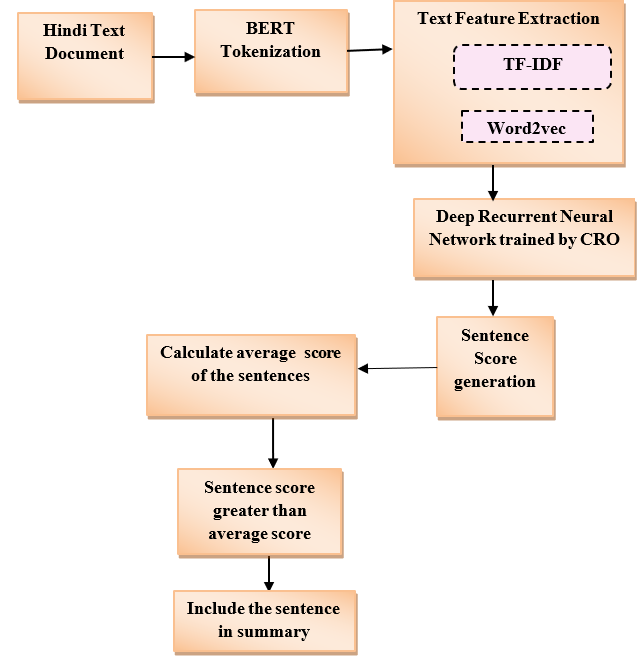Hybrid Optimization Based Hindi Document Summarization Using Deep Learning Technique
Main Article Content
Abstract
The proliferation of textual information today is a result of the internet's recent development, which is widely accessible to anybody, at any time. Generally speaking, several Natural Language Processing (NLP) techniques can be used to analyze the textual information that is offered on the basis of text documents. In recent years, various text summarization techniques have been implemented in English text documents but a little amount of work is carried out in Hindi text documents summarization. In this research investigation, the Coot Remora Optimization (CRO) technique based on Deep Recurrent Neural Network (DRNN) is used to summarize Hindi documents. Here, the CRO algorithm is used to train the DRNN, which is used to compute the sentence scores.The highest scored sentences are going to included in the summary. When compared to recent optimization algorithmic techniques, such as MCRMR-SSO, Graph-based_PSO, Genetic Algorithms (GA), and Political Elephant Herding Optimization (PEHO) based Deep Long Short Term Memory (DLSTM) algorithm, the developed method is shown to be superior. Additionally, three evaluation metrics such as precision, recall, f-measure are used to analyze the performance of the CRO based DRNN technique and obtained high performance.
Article Details
References
Pareek, G., Modi, D. and Athaiya, A., “A Meticulous Approach for Extractive based Hindi Text Summarization using Genetic Algorithm”, 2017.
Vimal Kumar, K. and Yadav, D., “An improvised extractive approach to Hindi text summarization”, In proceedings of Information systems design and intelligent applications, pp. 291-300, Springer, New Delhi, 2015.
Bafna, P.B. and Saini, J.R., “Hindi multi-document word cloud-based summarization through unsupervised learning”, In proceedings of 2019 9th International Conference on Emerging Trends in Engineering and Technology-Signal and Information Processing (ICETET-SIP-19), pp. 1-7. IEEE, November 2019.
Gupta, M. and Garg, N.K., “Text summarization of Hindi documents using rule based approach”, In proceedings of 2016 international conference on micro-electronics and telecommunication engineering (ICMETE), pp. 366-370, IEEE, September 2016.
Thaokar, C. and Malik, L., “Test model for summarizing hindi text using extraction method”, In proceedings of 2013 IEEE Conference on Information & Communication Technologies (pp. 1138-1143), IEEE, April 2013.
Yao, J.G., Wan, X. and Xiao, J., “Recent advances in document summarization”, Knowledge and Information Systems, vol.53, no.2, pp.297-336, 2017.M. Young, The Technical Writer’s Handbook. Mill Valley, CA: University Science, 1989.
Khurana, A. and Bhatnagar, V., “Investigating entropy for extractive document summarization”, Expert Systems with Applications, vol.187, p.115820, 2022.
Katoch, S., Chauhan, S.S. and Kumar, V., “A review on genetic algorithm: past, present, and future”, Multimedia Tools and Applications, vol.80, no.5, pp.8091-8126, 2021.
Kumar, K.V., Yadav, D. and Sharma, A., “Graph based technique for Hindi text summarization”, In proceedings of Information systems design and intelligent applications, pp. 301-310, Springer, New Delhi, 2015.
Jain, A., Arora, A., Morato, J., Yadav, D. and Kumar, K.V., “Automatic text summarization for Hindi using real coded genetic algorithm”, Applied Sciences, vol.12, no.13, p.6584, 2022.
Rahim Khan, Yurong Qian, and Sajid Naeem; "Extractive based Text Summarization Using K-Means and TF-IDF", International Journal of Information Engineering & Electronic Business, vol.11, no.3, 2019.
Wang, D., Tan, D. and Liu, L., “Particle swarm optimization algorithm: an overview”, Soft computing, vol.22, no.2, pp.387-408, 2018.
Gulati, A.N. and Sawarkar, S.D., “A novel technique for multidocument Hindi text summarization”, In proceedings of 2017 international conference on nascent technologies in engineering (ICNTE), pp. 1-6, IEEE, January 2017.
Dalal, V. and Malik, L., “Semantic graph based automatic text summarization for hindi documents using particle swarm optimization”, In International Conference on Information and Communication Technology for Intelligent Systems, pp. 284-289, Springer, Cham, March, 2017.
Pradeepika Verma; and Hari Om; "MCRMR: Maximum coverage and relevancy with minimal redundancy based multi-document summarization", Expert Systems with Applications, vol.120, pp.43-56, 2019.
Bandari, S. and Bulusu, V.V., “Feature extraction based deep long short term memory for Hindi document summarization using political elephant herding optimization” International Journal of Intelligent Robotics and Applications, pp.1-16, 2022.
Rupal Bhargava, Gargi Sharma, and Yashvardhan Sharma; "Deep text summarization using generative adversarial networks in indian languages", Procedia Computer Science, 167, pp.147-153, 2020.
Devlin, J., Chang, M.W., Lee, K. and Toutanova, K., “Bert: Pre-training of deep bidirectional transformers for language understanding”, arXiv preprint arXiv:1810.04805, 2018.
Liu, Q., Wang, J., Zhang, D., Yang, Y. and Wang, N., “Text features extraction based on TF-IDF associating semantic”, In proceedings of IEEE 4th International Conference on Computer and Communications (ICCC), pp. 2338-2343, December 2018.
Lilleberg, J., Zhu, Y. and Zhang, Y., “Support vector machines and word2vec for text classification with semantic features”, In proceeding of 2015 IEEE 14th International Conference on Cognitive Informatics &Cognitive Computing (ICCI* CC), pp. 136 140, IEEE ,July 2015.
Inoue, M., Inoue, S. and Nishida, T., “Deep recurrent neural network for mobile human activity recognition with high throughput”. Artificial Life and Robotics, vol.23, no.2, pp.173-185, 2018.
Jia, H., Peng, X. and Lang, C., “Remora optimization algorithm”, Expert Systems with Applications, vol.185, p.115665, 2021.
Naruei, I. and Keynia, F., “A new optimization method based on COOT bird natural life model”, Expert Systems with Applications, vol.183, pp.115352, 2021.
Bandari, S. and Bulusu, V.V., “BERT Tokenization and Hybrid-Optimized Deep Recurrent Neural Network for Hindi Document Summarization”, International Journal of Fuzzy System Applications (IJFSA), vol.11, no.1, pp.1-28, 2022.
Hindi Text Short Summarization Corpus data set available at “https://www.kaggle.com/disisbig/hindi-text-short-summarization-corpus”, accessed on December 2022.

